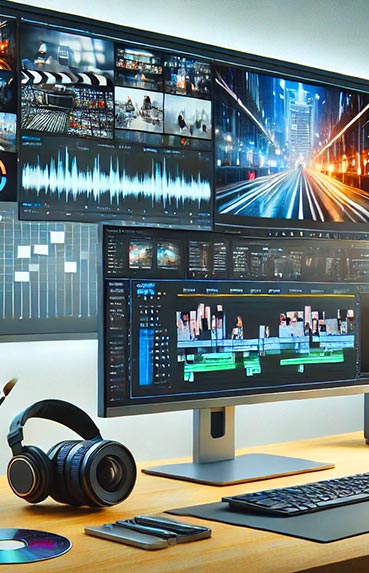In today's digital era, video content has become an essential tool for communication, education, and entertainment. However, the question of whether it's better to use live video or recorded video remains a topic of debate among content creators, businesses, and educators. Each format has its own advantages and challenges, and the choice between one and the other can depend on multiple factors, including the content's purpose, target audience, and available resources. In this article, we will explore the characteristics of both types of video, provide practical tips, and offer concrete examples to help you decide which might work best for your specific needs.
The Nature of Live Video
Live video refers to the real-time broadcast of events, where content is streamed directly to the audience as it happens. This format has gained popularity thanks to platforms like Facebook Live, Instagram Live, and Twitch, which allow users to connect with their audiences instantly.
Advantages of Live Video
Real-time interactivity: One of the biggest advantages of live video is the ability to interact directly with the audience. Viewers can ask questions, leave comments, and receive immediate responses, fostering a sense of community and participation.
Authenticity: Live video offers a sense of authenticity that can be difficult to replicate with recorded content. The spontaneity of live broadcasts can make the content seem more genuine and less rehearsed.
Urgency and exclusivity: Live broadcasts can create a sense of urgency and exclusivity. Viewers often feel they are experiencing something special and unique, which can increase interest and engagement.
Challenges of Live Video
Lack of control: One of the main disadvantages of live video is the lack of control over the content. Mistakes, technical issues, or unforeseen situations can occur and affect the quality of the broadcast.
Requires planning and preparation: Although live video may seem spontaneous, it often requires careful planning and preparation to ensure the broadcast is smooth and professional.
Technological limitations: The quality of live video can depend on factors like internet connection and the equipment used. This can be a challenge for those with limited resources.
The Versatility of Recorded Video
Recorded video, on the other hand, refers to content that has been pre-recorded and edited before being distributed to the audience. This format has been the foundation of video production for decades and remains a popular option for a variety of applications.
Advantages of Recorded Video
Complete control over content: One of the biggest advantages of recorded video is the complete control it offers over the content. Creators can edit and polish the video to ensure it meets the desired quality standards.
Flexibility in production: Recorded video allows creators to work at their own pace, which can be especially useful for more complex or detailed projects.
Accessibility: Recorded content can be viewed at any time and place, making it accessible to global audiences in different time zones.
Challenges of Recorded Video
Less immediate interaction: Unlike live video, recorded video does not allow for the same real-time interaction with the audience, which can limit engagement and participation.
May seem less authentic: Some viewers may perceive recorded content as less authentic or spontaneous compared to live broadcasts.
Requires editing skills: The production of recorded video often requires editing skills and access to editing software, which can be a barrier for some creators.
Comparing Live Video and Recorded Video
To determine which of these formats might work best for your needs, it's helpful to compare their key characteristics.
Content Purpose
Education and training: If the goal is to educate or train, recorded video may be more suitable due to its ability to be edited and perfected. However, live video can be useful for Q&A sessions or real-time discussions.
Marketing and promotion: Live video can be more effective in generating excitement and engagement in marketing campaigns, while recorded video may be ideal for more structured promotional content.
Target Audience
Audience engagement: If your audience values real-time interaction and engagement, live video may be the best option. On the other hand, if they prefer to consume content at their own pace, recorded video might be more appropriate.
Demographics: It's important to consider your audience's demographic preferences. For example, younger audiences may lean more towards live content due to their presence on social platforms that promote this type of format.
80% of consumers prefer to watch a live video from a brand rather than read a blog, according to Livestream data.
Resources and Technical Capabilities
Budget: Recorded video may require an initial investment in editing software and recording equipment, while live video might need fewer resources but a good internet connection.
Equipment and skills: Consider if you have access to the necessary equipment and technical skills to produce high-quality content in the chosen format.
Practical Tips for Choosing the Right Format
When considering whether to use live or recorded video, keep the following tips in mind:
Define your objectives clearly: Before deciding, make sure you have clear objectives and what you hope to achieve with the video content.
Know your audience: Research and understand your audience's preferences to choose the format that best suits their needs and expectations.
Evaluate your resources: Consider the available resources, including time, budget, and technical skills, to determine which format is more viable for you.
Experiment and analyze: Don't be afraid to experiment with both formats and analyze the results to see which generates more impact and engagement.
Keep quality in mind: Regardless of the format you choose, ensure the content is high quality and relevant to your audience.
Concrete Examples of Live and Recorded Video Use
To illustrate how these formats can be applied, here are some concrete examples:
Live Video Example
Interactive webinars: A software company hosts a live webinar to introduce a new product, allowing attendees to ask questions in real-time and get immediate answers from experts.
Live events: A charity organization broadcasts a fundraising event live, enabling viewers to watch performances in real-time and make donations on the spot.
Recorded Video Example
Online courses: An educational platform offers pre-recorded online courses that students can follow at their own pace, with the ability to pause, rewind, and review the content as needed.
Marketing campaigns: A fashion brand creates a recorded promotional video showcasing its new collection, allowing for careful editing to display the products in the best possible way.
Ultimately, the choice between live and recorded video will depend on your specific objectives, the nature of your audience, and the available resources. Both formats have the potential to be powerful communication and marketing tools if used effectively.

















